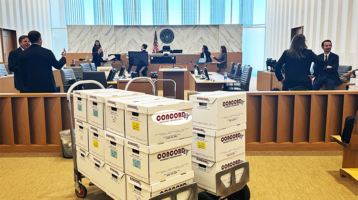How to Calculate ROI for E-Discovery (with Calculator)
Call CONCORD today (800) 246-7881
March 28, 2014 by Richard Medina
In previous posts I talked about doing a business case to see if its worth fixing e-discovery, for example in How to Develop and Implement Your Discovery Readiness Program and Which Part of E-Discovery Should You Fix First?. In this post I use a case study to explain how to calculate the ROI for improving the E-D processes. Then I provide a calculator you can use to model your own situation. If the case study bores you, just scroll down and download the calculator. Take a whack at it with your firms own numbers.
SUMMARY
Lets walk through the story and E-D business case of a company named ACME spends $6.5 million annually on discovery of electronically stored information (ESI) related to litigation matters. Over the past 3 years, the firm has experienced an average of twelve discovery events annually, of which two are typically more rigorous efforts. ACME asked a consulting firm picking a name at random, lets call this firm Doculabs to determine potential savings available to ACME through the use of content management and e-discovery technologies. Doculabs estimates ACME can save $8.9 million over a 3-year period, requiring an investment of $4.2 million, resulting in a net benefit of $4.7Â million.Doculabs excluded two other benefit streams: reduced storage expenditures, as these savings were accrued previously (Ill explain this type of archiving analysis in a later post); and productivity improvements in day-to-day functions, such as quickly retrieving documents to support customer service, as these are considered by ACME.
.
METHODOLOGY AND ANALYSIS
The savings estimates are based on industry metrics collected from Doculabs clients leveraging similar capabilities and technology. These client organizations range in revenues from $1.5 billion to $27 billion and represent a cross-section of industries.For ACME, Doculabs considered a variety of factors to estimate the current and future costs of e-discovery. The primary cost drivers are the frequency and magnitude of discovery events. The scope of analysis was limited to litigation-related events. Based on historical data, 12 events is the average. Proper preparation for discovery could save ACME an estimated $8.9 million over 3 years. But the number of discovery events doubles if regulatory and audit activities are considered. Analysis shows that the net benefit would jump to $13.6 million over 3 years if these additional activities are included. Adding two exhaustive discovery events (e.g. if ACME were to have to protect several of its patents or justify its pricing practices) also alters the economics. In this case, the net benefit would climb to $22.5 million.
Overall, ACMEs discovery efforts are labor-intensive and ripe for automation. Consider the 19 labor hours associated with discovery, on a per-gigabyte basis. The majority of those efforts are sourced from low cost review specialists, a prudent cost-control tactic. But a considerable amount of internal legal work is still involved, driving up cost. Anything that reduces the quantity of content to be collected and reviewed saves money. In recent years, the typical ACME custodian averages just over 3 GB of content to be reviewed. Reducing the volume of content on shared and local drives by 20%, the duplicate email by 30%, and then applying records disposition to the remainder reduces the amount of content entering the discovery process to about 2 GB per custodian.
The investment required to achieve the projected benefits is based on the pricing of leading suppliers in the market. These cost estimates assume that ACMEs baseline infrastructure used for document imaging can be leveraged for RM and e-discovery.
.
FINANCIAL IMPACT MODEL (THE CALCULATOR)
Doculabs analysis incorporates 28 different variables and uses industry metrics as the basis for the assumptions outlined below.
To help firms like ACME with understanding the potential impact of enterprise e-discovery capabilities, we use a visualization tool like the one I provided in Capture ROI Calculator and White Paper. Users can view and change the underlying assumptions of the model for example, changing the number of discovery events, the number of custodians per event, or the amount of content per custodian. The default assumptions that appear when the model is opened are what Doculabs expects the overall financial impact to be for ACME when all of the benefit streams are applied by invoking each of the functional capabilities.Heres what it looks like and which buttons to click:
[/mp_text]
[/mp_span]
[/mp_row]






